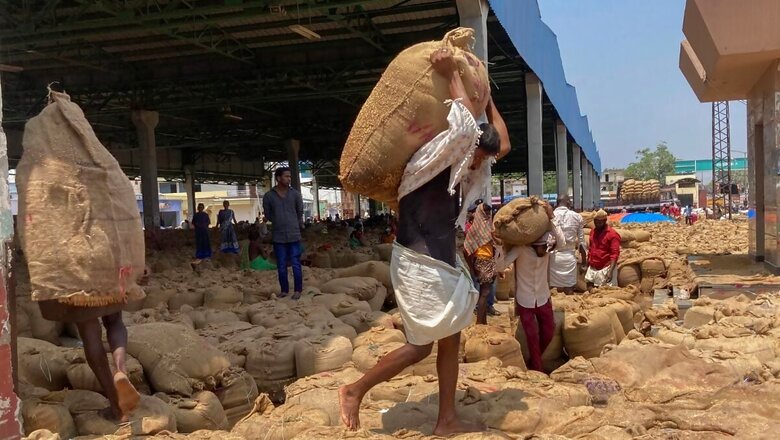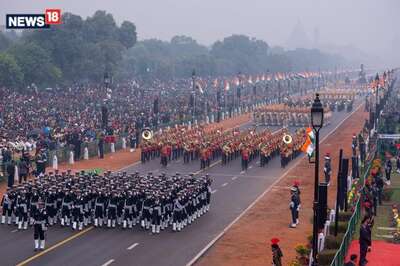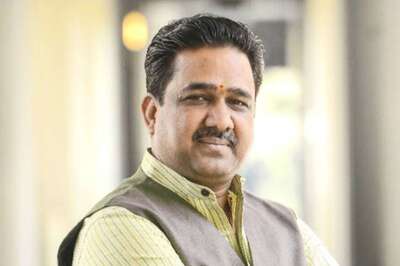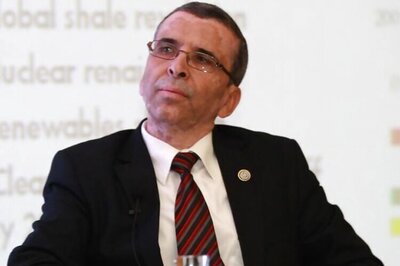
views
Amid the sweltering heat in Raichur, which will go to polls in the third phase of the Lok Sabha elections on May 7, the political battle between the BJP and Congress will be a hotly contested one. The tight two-way fight between the two parties will have the incumbent “royal” MP and a former IAS officer, who has served in Raichur.
The Congress, which is in power in Karnataka since it won the assembly election last year, has deployed its party machinery in the state including chief minister Siddaramaiah to counter the Modi factor. Last year, the Congress bagged five seats — Shorapur, Shahapur, Yadgir, Raichur rural and Manvi, while the BJP won Raichur and Lingsugur and JD(S) secured Devadurga.
The BJP’s alliance with the JD(S) may prove to be crucial in the Lok Sabha seat as the regional party was the third largest player in 2023 polls, winning the Devadurga seat with more than 34,000 votes. While the Congress and BJP secured 38.9 per cent and 38.3 per cent of the votes, the JD(S) secured 15.7 per cent.
A bypoll is also scheduled for the Shorapur constituency after the death of MLA Raja Venkatappa Naik.
Raichur is one of Karnataka’s 28 Lok Sabha constituencies and is reserved for the scheduled tribes. It encompasses parts of Raichur and Yadgir districts. It has eight assembly segments — Shorapur (ST), Shahapur, and Yadgir in Yadgir district, and Raichur rural (ST), Raichur, Manvi (ST), Devadurga (ST), and Lingsugur (SC) in Raichur district.
It is presently represented by Raja Amareshwara Naik of the BJP since 2019, and the BJP has decided to repeated him this time as well. The Congress has fielded G Kumar Naik, who is a former civil servant.
Where the BJP stands
Traditionally a Congress bastion, the BJP first breached Raichur in 2009 when Sanna Pakirappa emerged victorious. The Congress wrested the seat back in 2014, but, in 2019, it lost by a heavy margin of 1.17 lakh votes to the BJP’s royal face Raja Amareshwara Naik.
Naik, who had previously been a Congress member and then a JD(S) leader, joined the BJP in 2014. He comes from the royal family of Guragunta and Shorapur in Raichur, commanding tremendous sway among the people, especially the tribal community that forms almost 18 per cent of the vote.
He is known for being a development-oriented leader. He is respected for his royal blood and the family’s historical link with the ST community. While anti-incumbency is a concern, the BJP still perceives him as its best bid in the constituency.
In 2019, Naik had defeated former MP BV Nayak, the son of formidable Congress leader and three-time MP Venkatesh Nayak. At the time, the saffron party had attacked the legacy of the father-son duo and managed to register a victory.
BV Nayak went on to join the BJP later and, in 2023, he was given a ticket from the Mandvi assembly seat, which he lost by a margin of 7,719 votes. He was still hopeful for a Lok Sabha ticket in 2024 and expressed his dissatisfaction when the sitting MP was nominated by the BJP. His discontentment has complicated matters and led to fears of internal damage to Naik’s campaign.
With no controversies tied to his name and a focus on development-based issues, the royal MP remains in a favourable position. He is bolstered by the Modi factor as the prime minister has a massive following here, owing to the different central welfare schemes, development agenda and national issues such as Ram Mandir and national security.
Hindutva has sizeable support, with the Ayodhya temple inauguration being celebrated across the constituency. Moreover, the JD(S), in alliance with the BJP in Karnataka, may significantly contribute to the candidate’s fortunes.
Voters from the ST community comprise a little under three lakh votes. A major chunk of ST voters lean towards the NDA with multiple factors, including support for Prime Minister Modi, loyalty towards the royal family and the JD(S) stronghold in Devadurga and considerable influence in Manvi and Lingsugur.
Lingayat voters, who form a core base for the BJP, account for about 3.8 lakh votes. The BJP also has Raichur MLA Shivraj Patil and Lingsugur MLA Manama D Vajjal to lean on to draw support.
Where the Congress stands
The Congress nominee, G Kumar Naik, is a retired 1990 Karnataka-cadre IAS officer who has served as deputy commissioner in Raichur between 1999 and 2002. Having served the constituency before, he said he worked hard for the people back then and is also perceived to have a hold over the issues in the region. But, he is a new face in politics and has his work cut out to convince voters.
G Kumar Naik has been termed as an “outsider” by his rivals in the BJP and is trying to combat that narrative. He is backed by Manvi MLA NS Bose Raju, who holds the state portfolios of science and technology as well as minor irrigation in the Siddaramaiah-led cabinet.
Having bagged five assembly seats out of eight in Raichur in 2023, the Congress is confident of a formidable turnout in its favour. The minority vote from the Muslim community, which is a core vote bank of the Congress, accounts for much over 16.8 per cent of the total voter population.
The Siddaramaiah factor among the Kurubas is also strong here. Kurubas are a loyal vote bank for the chief minister, who comes from the community, and accounts for around 3.15 lakh votes. A significant portion of the SC vote (21.7 per cent) and a considerable percentage of ST voters are also drawn towards the Congress this time.
Moreover, the five guarantees under the Congress, which have been implemented rapidly after the 2023 assembly polls, are a major political success for the party as they countered the Centre’s welfarism with its own version. The party, however, has been unable to counter the BJP’s Hindutva politics, which sours its prospects among Hindu voters. It also does not have a national leadership to offer to counteract the Modi factor, with minimal popularity for Rahul Gandhi.
Here are some key issues at play in Raichur Lok Sabha constituency:
- BJP vs Congress on welfare schemes: The BJP alleges that the Congress, with its five guarantees, has disturbed the fiscal stability of Karnataka. Recently, former CM Basavaraj Bommai, who is the BJP candidate for the Gadag-Haveri Lok Sabha constituency, launched a blistering critique against the government’s fiscal management, alleging that it is driving the state towards bankruptcy. The BJP also accuses the Congress of discontinuing the ‘Kisan Samman Nidhi’ and ‘Vidya Nidhi’ schemes.
- Communal tension: While a considerable portion of the Hindu community is drawn towards the Hindutva brand of politics by the BJP, Muslim voters are opposed to it. A major bone of contention between the two communities is former Mysuru ruler Tipu Sultan’s legacy, which Muslim voters are drawn to preserve but followers of Hindutva politics are against. A protest in late January over the purported desecration of a portrait of Tipu Sultan escalated, leading to heightened communal tension in the region. Last year, reacting to a social media post on Islam, angered Muslims gathered in a group and reportedly attempted to barge into a Hindu temple. This post was made by a young woman and heated arguments took place between members of the two communities before the situation was diffused by the police.
- Water contamination: Water contamination and the ailments caused by them remain a serious issue in Raichur. A recent study by the district health department in three out of the six affected villages shows an increase in cases of asthma and other health issues due to drinking borewell water. The baseline survey by doctors of Raichur Institute of Medical Sciences shows that there is higher fluoride content in groundwater. According to reports, people feel apprehensive whenever they drink water.
- Industrial pollution: The industrial area, which is only 12 km from Raichur city, houses nearly 75 industries and has the second-highest density of chemical industries in the state. It has 19 chemical industries, including 12 pharmaceutical companies. Chemical industries are releasing untreated effluents into water bodies and fields. The area is also home to two thermal power plants and there have been several instances of chemical industries dumping waste in open fields and water bodies. People have reportedly provided video and photographic evidence about industries discharging waste into water bodies and farms, but nothing has been done to address the situation. Chemical factories also discharge chemicals in the air at night as the pungent smell remains throughout the day causing suffering for the population in the vicinity.
- Droughts: Raichur, known for its crippling heat despite being in the vicinity of two major rivers Mahanadi and Kharun, has suffered major droughts. Moreover, erratic rains over the past few years have added to the burden. The administration set up a task force and provided funds at the taluk and tehsil level to mitigate the water crisis but this has failed to achieve the desired effect.
- Electricity: Despite providing a gigantic 40 per cent of Karnataka’s electricity and two thermal power plants in vicinity, the region suffers from a shortage of power and load shedding. While the situation in urban areas is relatively better, rural areas only receive six hours of electricity a day. According to reports, people have voiced their displeasure at the inefficient distribution from the Raichur thermal power station.
- Farmer issues: Two years of relentless drought have led to devastating crop failures, leaving farmers without a safety net due to the lack of crop insurance. The situation is worsened by limited access to electricity, with only six hours of power available per day, hindering irrigation efforts. Despite having two rivers and existing irrigation facilities, water scarcity remains a major concern, with demands for 100 per cent irrigation cover to address the current 40 per cent coverage. Additionally, the existing mandi system and APMCs are seen as exploitative, with farmers seeking to eliminate middlemen and gain fairer prices for their produce.
- Unemployment and emigration: While the chemical and non-chemical industries provide around 5,000 to 10,000 local jobs, unemployment has remained a major issue in Raichur. This has caused the majority of the youth to seek employment elsewhere, either in the urban centres of Karnataka or migrating to Maharashtra. Another issue that has borne out the rising unemployment, is underemployment as people who had once migrated out for higher education return home and take up menial jobs.
- Health facilities: While the city of Raichur possesses a healthy amount of healthcare options and hospitals, the rest of the constituency still languishes in the area. The rise of health issues arising out of water contamination has crippled the existing healthcare facilities in the rural areas. People have been complaining of fluorosis, asthma, severe joint pain, yellowing of teeth and stomach ache. Moreover, in the urban centres, people have voiced their disappointment over the Centre’s failure to open an AIIMS in the region.
- Connectivity: Lack of railway and highway connectivity has impacted the region’s economic growth. According to on-ground reports, rural roads are in a state of disrepair hampering intra-connectivity in the constituency. To provide better connectivity, the central government has envisaged to connect Raichur with the Bharatmala projects, the construction of which has just started. Raichur has a small airport, which can hardly cater to the needs of the people, with a lack of commercial flight connections. The state government has recently pledged Rs 14 crore for development works, but it remains unclear if there are plans to expand the airport. The nearest airport from Raichur is in Hyderabad, 190 km away.
Voter Demographic (as per 2011 Census)
Total Voters (2019): 19,27,758
Urban Voters: 27%
Rural Voters: 73%
Social Composition
SC: 21.7%
ST: 18.1%
Religious Composition
Hindu: ~83%
Muslim: 16.8%
Check Lok Sabha Election 2024 Phase 3 Schedule, Key Candidates And Constituencies At News18 Website.




















Comments
0 comment